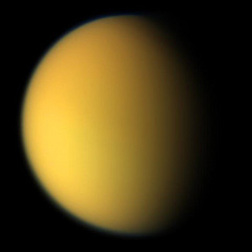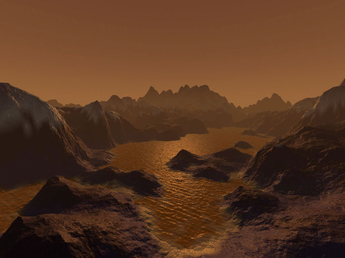Our Solar System
Titan

Titan is the biggest of the 53 known moons orbiting Saturn. It is a cold world enclosed by a thick, hazy atmosphere impenetrable by telescopes and cameras. With an equatorial radius of 2,575 km (1,600 miles), Titan is the second largest moon in our solar system. It's bigger than our own Moon and even the planet Mercury. Only Jupiter's moon Ganymede is larger than Titan, with a diameter barely 112 km (62 miles) greater. The temperature at Titan's surface is about -289 degrees Fahrenheit (-178 degrees Celsius). Titan orbits Saturn at a distance of about 1.2 million km (745,000 miles), taking almost 16 days to complete a full orbit.
Titan is of great interest to scientists because it is the only moon in the solar system known to have clouds and a mysterious, thick, planet-like atmosphere. NASA's Cassini-Huygens spacecraft (currently orbiting Saturn) should shed new light on Titan's mysteries. The spacecraft's instruments are designed to reveal many of Titan's characteristics. During dozens of flybys, the Cassini orbiter maped Titan with cloud-penetrating radar and collect atmospheric data. The Huygens probe dove through Titan's dense atmosphere on 14 January 2005 with instruments capable of analyzing its components.
Titan is of great interest to scientists because it is the only moon in the solar system known to have clouds and a mysterious, thick, planet-like atmosphere. NASA's Cassini-Huygens spacecraft (currently orbiting Saturn) should shed new light on Titan's mysteries. The spacecraft's instruments are designed to reveal many of Titan's characteristics. During dozens of flybys, the Cassini orbiter maped Titan with cloud-penetrating radar and collect atmospheric data. The Huygens probe dove through Titan's dense atmosphere on 14 January 2005 with instruments capable of analyzing its components.
Titan's Atmosphere

The atmosphere of Titan is made mostly of nitrogen (80-90%), just like the Earth's atmosphere! Titan is the only other place in the solar system with an atmosphere made out of the same thing as the Earth's. Titan's atmosphere is very dense, and the air pressure at the surface is even higher than Earth's atmospheric pressure.
Titan also has some methane in its air. Sunlight breaks down the methane and forms other chemicals, too. Those chemicals create layers of haze or smog in Titan's atmosphere. Titan is very cold (-178º C or -288º F). Methane, which is a gas on Earth, turns to liquid in many places on Titan. The Cassini spacecraft has spotted clouds of methane and ethane in Titan's atmosphere. The clouds are near Titan's poles. There is probably even methane and/or ethane rain and snow on Titan. This picture shows what the different parts of Titan's atmosphere might be like.
Titan also has some methane in its air. Sunlight breaks down the methane and forms other chemicals, too. Those chemicals create layers of haze or smog in Titan's atmosphere. Titan is very cold (-178º C or -288º F). Methane, which is a gas on Earth, turns to liquid in many places on Titan. The Cassini spacecraft has spotted clouds of methane and ethane in Titan's atmosphere. The clouds are near Titan's poles. There is probably even methane and/or ethane rain and snow on Titan. This picture shows what the different parts of Titan's atmosphere might be like.
Features of Titan

Titan is the only known moon with a fully developed, planet-like atmosphere. Unfortunately, this thick atmosphere prevented us from learning much about its surface features during the Voyager missions. What we do know is that it appears to be composed of about half water ice and half rocky material. It is believed to be similar in composition to many of Saturn's other moons, but is much denser because of its large size and higher gravity. Titan's atmosphere is believed to have two cloud layers at about 125 miles (200 km) and 186 miles (300 km) above the surface. It is possible that these clouds produce a rain of liquid methane onto Titan's surface. In fact, it is possible that there may be pools or even oceans of liquid methane on Titan's surface. Recent ground-based radar observations have cast some doubt on this theory, however.
Titan has no known magnetic field, and sometimes orbits outside Saturn's magnetosphere. This exposes it directly to the solar wind, which may ionize and remove particles from the atmosphere. In 2004, the Cassini probe arrived at Saturn and dropped a probe called Huygens into Titan's atmosphere. It landed and sent back images of the surface as well as measurements of Titan's atmosphere. Cassini was then able to map Titan's surface using radar, as was done on the Magellan mission to Venus. As amazing as these images were, they only posed more questions than answers. But thanks to Cassini, we have now witnessed some of the most detailed images yet of the ringed planet and her moons.
Titan has no known magnetic field, and sometimes orbits outside Saturn's magnetosphere. This exposes it directly to the solar wind, which may ionize and remove particles from the atmosphere. In 2004, the Cassini probe arrived at Saturn and dropped a probe called Huygens into Titan's atmosphere. It landed and sent back images of the surface as well as measurements of Titan's atmosphere. Cassini was then able to map Titan's surface using radar, as was done on the Magellan mission to Venus. As amazing as these images were, they only posed more questions than answers. But thanks to Cassini, we have now witnessed some of the most detailed images yet of the ringed planet and her moons.
Statistics for Titan
Discovered by - Christiaan Huygens
Year of Discovery - 1655
Diameter - 3,200.6 miles (5,151 km)
Mean Distance from Saturn - 759,067 miles (1,221,850 km)
Rotational Period - 15.9 Days
Orbital Period - 15.9 Days
Orbital Eccentricity - 0.0292
Orbital Inclination - 0.33 degrees
Mean Surface Temperature - -289 F (-178 C)
Main Atmospheric Component - Nitrogen
Atmospheric Pressure - 1.5 bars
Apparent Magnitude - 8.28
Year of Discovery - 1655
Diameter - 3,200.6 miles (5,151 km)
Mean Distance from Saturn - 759,067 miles (1,221,850 km)
Rotational Period - 15.9 Days
Orbital Period - 15.9 Days
Orbital Eccentricity - 0.0292
Orbital Inclination - 0.33 degrees
Mean Surface Temperature - -289 F (-178 C)
Main Atmospheric Component - Nitrogen
Atmospheric Pressure - 1.5 bars
Apparent Magnitude - 8.28
